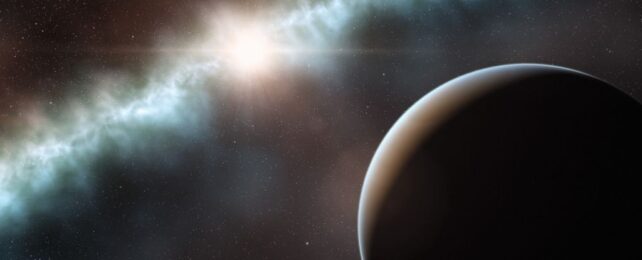TOI-4603b is nearly three times denser than Earth and orbits its star in just 7 days.
Key Takeaways:
- TOI-4603b is a Jupiter-sized exoplanet with a staggering density of 14.1 g/cm³—greater than lead.
- With a mass of nearly 13 Jupiters, it’s on the edge between a giant planet and a brown dwarf.
- The planet’s highly oval orbit suggests it is still migrating closer to its host star.
- Its rapid 7.25-day orbit places it among a rare class of massive, close-in exoplanets.
- Studying TOI-4603b could help scientists understand how giant planets and brown dwarfs evolve.
_________
A Planet That Defies Expectations
Astronomers have discovered an extraordinary exoplanet, TOI-4603b, orbiting a star 730 light-years away. What makes it remarkable is its extreme density—14.1 grams per cubic centimeter—making it denser than lead (11.3 g/cm³) and nearly three times the density of Earth (5.51 g/cm³). TOI-4603b is about the same size as Jupiter but has a mass 12.89 times greater, placing it on the borderline between a massive planet and a brown dwarf.
This discovery, led by Akanksha Khandelwal and her team from the Physical Research Laboratory in India, has been accepted for publication in Astronomy & Astrophysics Letters and is available on arXiv. The planet was first identified using NASA’s Transiting Exoplanet Survey Satellite (TESS), which detects exoplanets by observing dips in starlight as planets pass in front of their stars.

A Closer Look at TOI-4603b’s Unique Features
One of TOI-4603b’s most intriguing characteristics is its rapid orbit—completing a full trip around its star in just 7.25 days. Most brown dwarfs orbit their stars at much greater distances, making this discovery particularly unusual. The planet’s orbit is also highly eccentric, meaning it is not a perfect circle. This suggests that TOI-4603b may still be settling into its current position, possibly due to gravitational interactions with another nearby brown dwarf.
Scientists believe that studying TOI-4603b could provide key insights into how massive planets form and migrate. Similar objects, like HATS-70b, have been found in the past, but TOI-4603b stands out due to its extreme density. Further observations will help researchers determine whether it should be classified as a planet or a brown dwarf, and how its relationship with its star has evolved.
The discovery of TOI-4603b adds to a growing list of massive, close-in exoplanets that challenge traditional planetary formation models. By continuing to study such extreme worlds, astronomers hope to refine their understanding of how planets form, migrate, and interact with their host stars.




